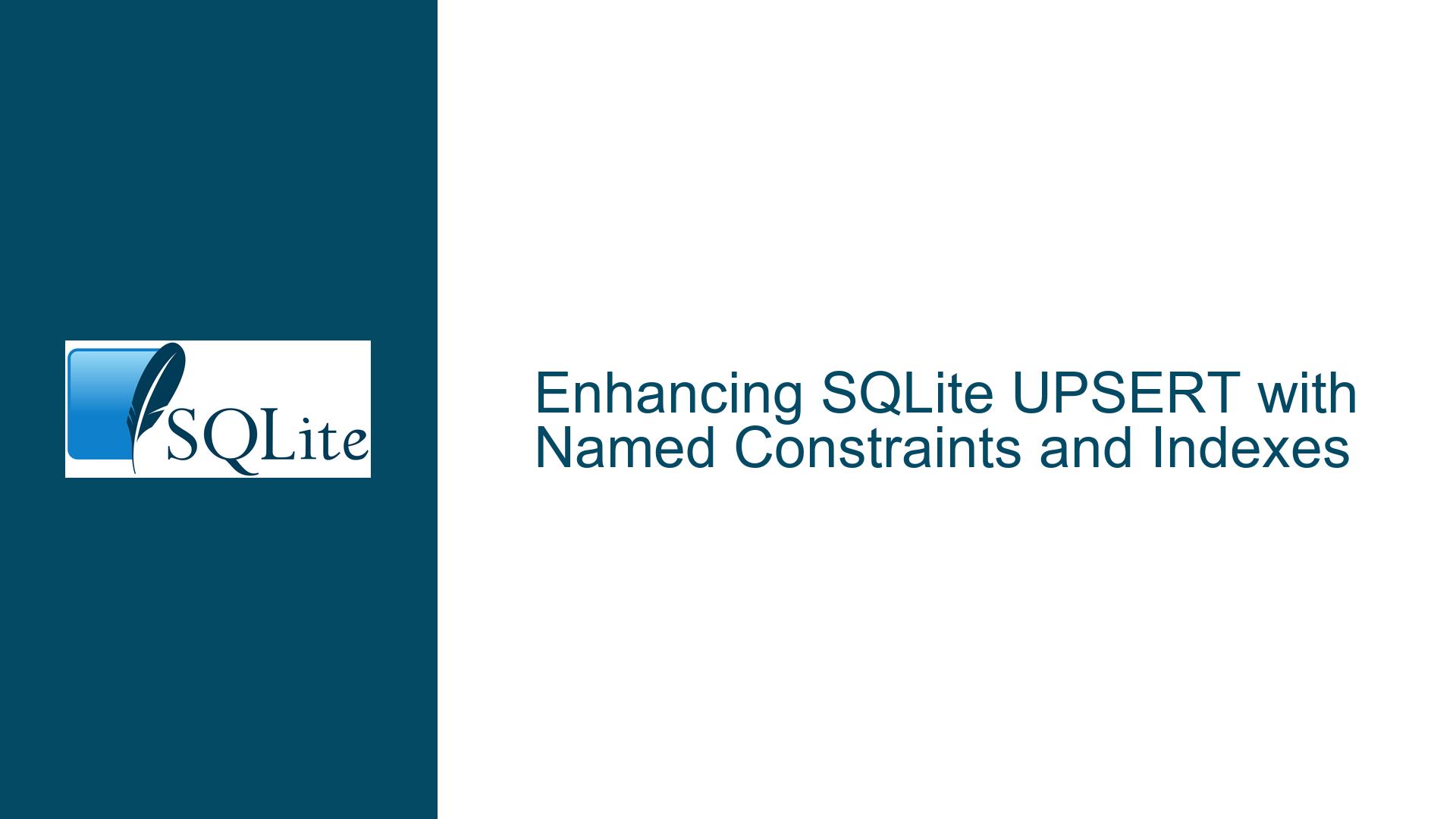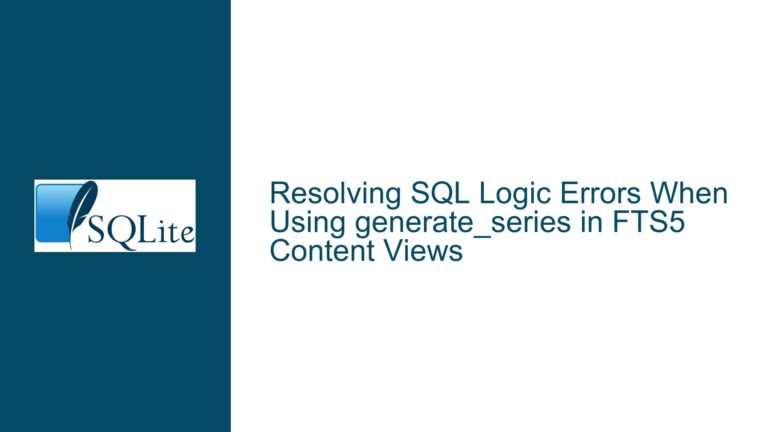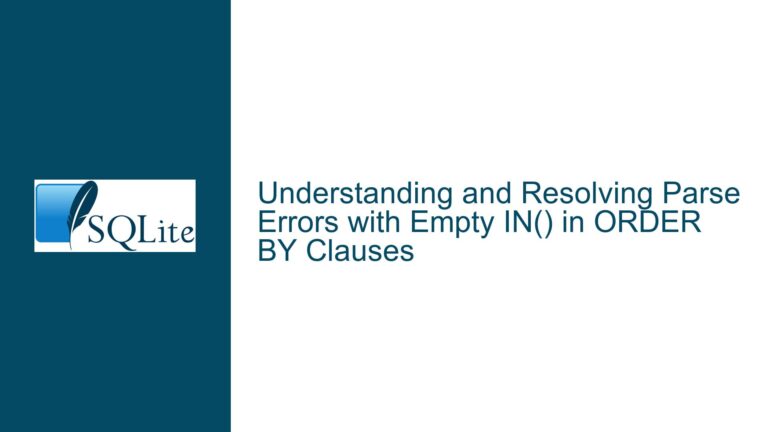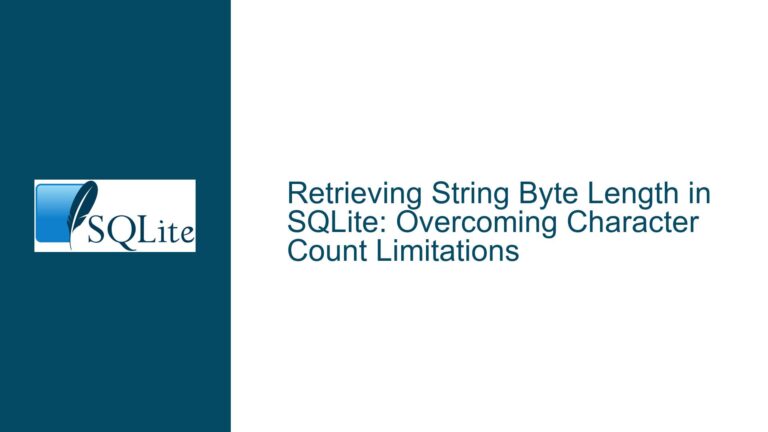Enhancing SQLite UPSERT with Named Constraints and Indexes
Understanding the Need for Named Constraints and Indexes in UPSERT
The core issue revolves around the verbosity and redundancy in SQLite’s UPSERT syntax, particularly when dealing with lengthy UNIQUE constraints or indexes. Currently, when performing an UPSERT operation, the ON CONFLICT clause requires the explicit listing of all columns involved in the UNIQUE constraint or index. This can become cumbersome and error-prone, especially when the column list is extensive or when the UNIQUE constraint involves complex expressions.
For example, consider a table TBL with columns a, b, c, d, e, f, g, h and a UNIQUE index idx on all these columns. The current UPSERT syntax requires the repetition of all these columns in the ON CONFLICT clause:
INSERT INTO tbl (a, b, c, d, e, f, g, h)
VALUES (...)
ON CONFLICT (a, b, c, d, e, f, g, h)
DO UPDATE SET count = count + 1;
The proposal is to allow referencing the UNIQUE constraint or index by name, thereby simplifying the syntax:
INSERT INTO tbl (a, b, c, d, e, f, g, h)
VALUES (...)
ON CONFLICT WITH INDEX idx
DO UPDATE SET count = count + 1;
This enhancement would not only reduce redundancy but also improve readability and maintainability of SQL code, especially in scenarios where the UNIQUE constraints or indexes involve complex expressions or a large number of columns.
Exploring the Ambiguity and Syntax Challenges
One of the primary challenges in implementing this enhancement is the potential for ambiguity between the index name and column names. If a column shares the same name as an index, the SQL parser might struggle to differentiate between them. This ambiguity could lead to parsing errors or unintended behavior.
To address this, the proposal suggests introducing additional syntax to explicitly specify whether the conflict target is an index or a constraint. For example:
ON CONFLICT WITH INDEX idx DO UPDATE SET count = count + 1;
or
ON CONFLICT WITH CONSTRAINT constraint_name DO UPDATE SET count = count + 1;
This explicit syntax would eliminate any ambiguity, ensuring that the SQL parser correctly identifies the conflict target. Additionally, this approach aligns with the syntax used in other databases like PostgreSQL, which already supports referencing constraints by name in the ON CONFLICT clause.
Addressing the Multiple NULLs Issue in UNIQUE Indexes
Another related issue discussed in the forum is the behavior of UNIQUE indexes in SQLite when dealing with NULL values. By default, SQLite treats NULLs as distinct in UNIQUE indexes, meaning multiple NULL values are allowed. This behavior can be problematic in scenarios where NULLs should be treated as equal, such as when enforcing a unique constraint on a nullable column.
To work around this limitation, the forum participants proposed several solutions. One approach involves creating a composite index that includes both the nullable column and a derived column indicating whether the original column is NULL. For example:
CREATE UNIQUE INDEX idx ON tbl (a IS NULL, COALESCE(a, ''), b IS NULL, COALESCE(b, ''));
This index ensures that NULL values are treated as equal, as the IS NULL and COALESCE expressions guarantee that all columns in the index are non-NULL. However, this approach can lead to verbose and complex index definitions, especially when dealing with multiple nullable columns.
An alternative solution involves creating a partial index that only includes rows where the nullable column is NULL:
CREATE UNIQUE INDEX xnull ON x(1) WHERE b IS NULL;
This index ensures that only one row with a NULL value in column b can exist in the table. While this approach is more concise, it may not be suitable for all scenarios, particularly when multiple nullable columns are involved.
Implementing the Proposed Enhancements in SQLite
To implement the proposed enhancements, SQLite would need to extend its parser and execution engine to support referencing constraints and indexes by name in the ON CONFLICT clause. This would involve:
Syntax Extension: Introducing new syntax to explicitly specify the conflict target as an index or constraint. This could be done by adding keywords like
WITH INDEXorWITH CONSTRAINTto theON CONFLICTclause.Ambiguity Resolution: Ensuring that the parser can correctly differentiate between column names and index/constraint names. This could be achieved by enforcing a naming convention or by requiring explicit syntax to disambiguate.
Execution Engine Modifications: Updating the execution engine to handle named conflict targets. This would involve looking up the specified index or constraint, retrieving the associated columns or expressions, and using them to determine the conflict.
Backward Compatibility: Ensuring that the new syntax does not break existing SQLite applications. This could be done by making the new syntax optional, allowing developers to continue using the current verbose syntax if desired.
Potential Downsides and Considerations
While the proposed enhancements offer significant benefits, there are several potential downsides and considerations to keep in mind:
Complexity: Introducing new syntax and modifying the parser and execution engine could increase the complexity of SQLite. This could make the codebase harder to maintain and increase the risk of introducing bugs.
Performance Impact: The additional lookups required to resolve named conflict targets could have a minor performance impact, particularly in scenarios with a large number of indexes or constraints.
Adoption Challenges: Developers may need to update their SQL code to take advantage of the new syntax. This could be a barrier to adoption, particularly in large codebases with extensive use of UPSERT operations.
Cross-Database Compatibility: While the proposed syntax aligns with PostgreSQL, it may differ from other databases. This could lead to compatibility issues when migrating SQL code between different database systems.
Conclusion
The proposed enhancement to SQLite’s UPSERT syntax, allowing the use of named constraints and indexes in the ON CONFLICT clause, addresses a significant pain point for developers dealing with lengthy or complex UNIQUE constraints. By reducing redundancy and improving readability, this enhancement would make SQLite more user-friendly and maintainable.
However, the implementation of this enhancement requires careful consideration of potential ambiguities, performance impacts, and backward compatibility. By addressing these challenges, SQLite could provide a more robust and flexible UPSERT mechanism, aligning it more closely with other modern databases like PostgreSQL.
In summary, while the current UPSERT syntax in SQLite is functional, the proposed enhancements offer a compelling opportunity to improve the language’s expressiveness and ease of use. By allowing developers to reference constraints and indexes by name, SQLite could become an even more powerful tool for managing complex data scenarios.






